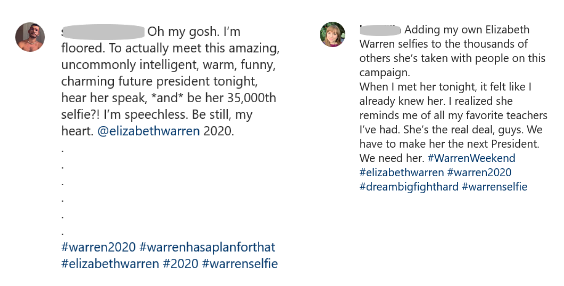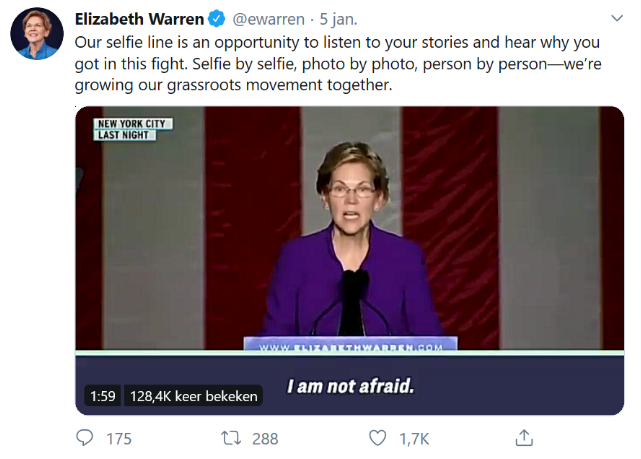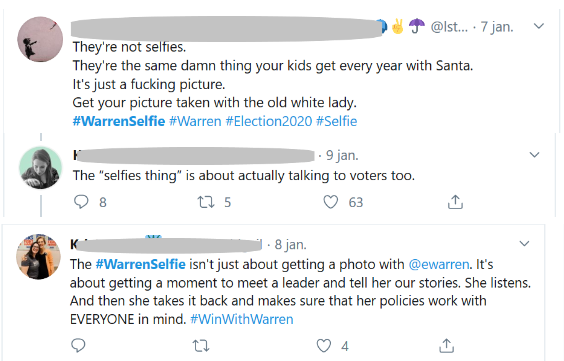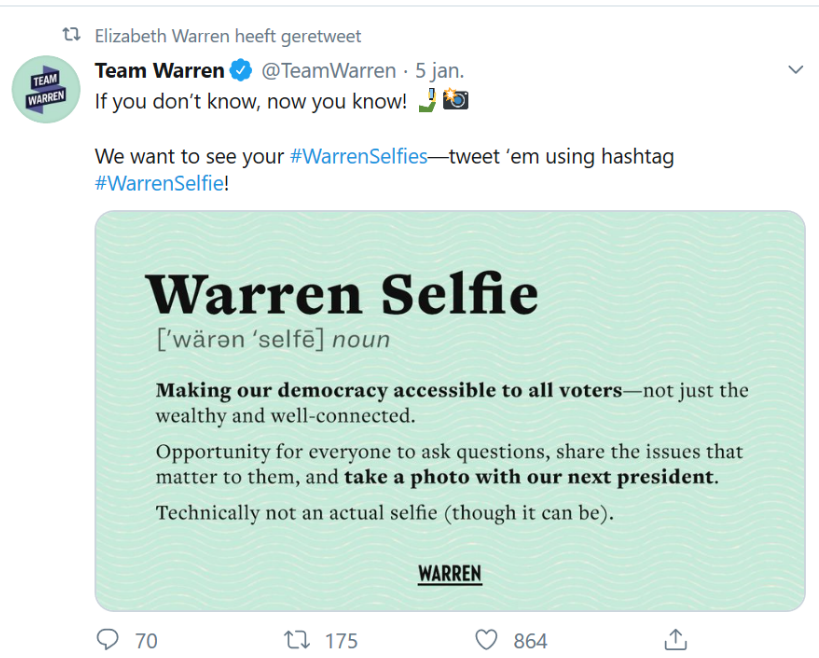
Elizabeth Warren: Campaigning with selfies
Elizabeth Warren is running for the 2020 US presidential elections with a remarkable social media strategy: selfies. How are "selfie lines" going to help Elizabeth Warren become the next President of the United States? In what follows, we will take a look at how selfies both online and offline can work to bring her message across to the voters.
Elizabeth Warren's selfie campaign
In November 2020, American citizens will elect their new President. One of the possible candidates for the Democratic Party at the moment is Elizabeth Warren. On her website, Warren calls her campaign a grassroots movement. She relies on individual volunteers to help her spread her message and give her financial support. This requires big organizing: next to the professional campaigners, it is mostly volunteer leaders that mobilize people on a local scale to organize events and do promotion (Bond & Exley, 2016). For this strategy to work, Warren needs to listen to the voters and try to establish a personal connection with them so that they might become part of her movement. Further, it is also important that the volunteers spread her message.
For these purposes, she introduced what she calls "selfie lines". After speeches and rallies, Warren invites to the stage every person willing to wait for a free picture with her. This also gives people the opportunity to have a short conversation with her and tell her what they think is important. It seems that many use this opportunity because she claims to have already taken more than 100.000 selfies, sometimes spending more than four hours to make sure every person waiting in line gets a picture with her (Fearnow, 2020). Why is this strategy so advantageous for Elizabeth Warren that she decides to spend so much time on it? How can selfies help her win the political battle?
The message of selfie lines
One of the reasons for the success of Elizabeth Warren’s selfie line is that it helps establish an image of her as a suitable candidate; it tells something about her identity. The way an image of a candidate is communicated is through their style. The words someone uses, but also body language and behaviour more generally contribute to the message they send to their audience (Silverstein, 2003). This message is important for politicians because voters choose which candidate to support based on their perceived message. So how do selfie lines contribute to the Elizabeth Warren's message?
"I got to pose for a picture and I got to hug her. You can tell she’s not a bunch of words."
Many US citizens seem to appreciate the approachability that Warren communicates. They praise the fact that she gives the opportunity for every person to talk to her and to share what is on their mind. A voter who waited for hours in line, for example, later said: “I got to pose for a picture and I got to hug her. You can tell she’s not a bunch of words" (Jennings, 2019). Many Instagram users also seem to value her personality posting statements like “When I met her tonight, it felt like I already knew her. I realized she reminds me of all my favourite teachers I’ve had” and “O my gosh. I’m floored. To actually meet this amazing, uncommonly intelligent, warm, funny, charming future president tonight.”
The message that Warren is sending by organizing these selfie lines and interacting with people in the process is that she is an approachable candidate. She is an ordinary person that is "one of them", someone who listens to and addresses the problems of ordinary citizens. Given that she has been a law professor in several Ivy League schools for a big part of her life, it is important for her to show that she is not an elitist candidate. This message might attract voters, but also volunteers, who will probably be more willing to contribute their time to the cause of a well-meaning, down-to-earth candidate.

Instagram Comments on Warren
Another message that is communicated through these selfie lines relates to Elizabeth Warren's health. Warren is seventy years old, and her age has caused people to question her physical condition asking whether she really will be able to do the hard work that comes with the job of being the President. However, if she manages to take pictures and talk to people for four hours at a time, she must be in good health. As The Independent wrote, “[the selfie lines] also show her stamina: what unhealthy person is able to stand for hours greeting strangers day in and day out?”
A discursive battle for meaning
Another very important aspect of the selfie lines is, of course, the selfie itself. Warren uses this word on her social media platforms and calls the line a selfie line, but technically, the pictures taken are not selfies. A campaigning assistant takes the pictures, not Warren herself. Why does she use the word "selfie" then? Usually, selfies are associated with individualism and ego-centrism. Taking selfies is something you do yourself and the individual is the centre of attention in the picture.
Selfies are the building blocks of the grassroots movement that Warren is trying to create.
However, Warren has managed to give a new meaning to the term. In the tweet below, she explains that the selfie line is an opportunity to listen to voters' stories; not something to do alone, but something to share with each other. Selfies are the building blocks of the grassroots movement that Warren is trying to create. The meaning that she is giving is one of selfies as unique moments of sharing ideas. This meaning is the complete opposite of what is usually associated with selfies.

Tweet by Elizabeth Warren
On Twitter, we can see the clash of these two different "meanings" of the word "selfie". Some users argue that Warren is using the wrong word: “they are not selfies, they are just pictures”. These users see the use of the word "selfie" as a marketing trick. In reaction to this, others argue, for example, that "the "selfies thing" is about actually talking to voters too”. It is not just about a photo, “it’s about getting a moment to meet a leader and tell her our stories. She listens. And then she takes it back and makes sure that her policies work with everyone in mind”.

Tweets about Warren's 'selfies'
The use of the word "selfie" also fits into the message that Elizabeth Warren wants to get across. The Washington Post writes about this: "She's using 'selfie' both to differentiate from those formal, posed, paid-for pictures, to emphasize the informality of the encounters — and as a way to show that she 'gets it.'" Selfies are associated with informal encounters, and this fits the image of Warren as "one of the people". Using this word implies that there is a difference compared to the picture-taking practices of other politicians. Her selfies are demotic and spontaneous, while some other politicians only pose for pictures formally and ask money for it, which then seems very undemocratic and unfair in comparison. In addition, the word "selfie" is a word that aligns with the spirit of the times. Using such a modern word might have a bigger effect among younger people and it takes away from the image of Warren as a very old candidate.
#WarrenSelfie
There is another advantage to taking pictures with people. Pictures - especially selfies - are very suitable for sharing on many social media platforms. In an interview, many voters who waited in line to take a picture with Elizabeth Warren said that they were planning on posting the picture on platforms like Instagram or Facebook. Of course, by doing so, they would be sharing this as a positive experience with their social media friends and followers, thus amplifying a positive message for Warren. In this way, the selfie lines are a way of generating free advertisement. Warren’s campaign team knows this and stimulates the sharing of the pictures on social media by introducing the hashtag #WarrenSelfie.

Tweet by Team Warren
The tweet above was posted by Team Warren, the page run by volunteers of her grassroots movement. It calls for people to share their photo with Warren, explicitly urging them to use the hashtag. This shows a great understanding of the media logic of the platform: they know that posts will get more visibility if they use a hashtag that a lot of people use. Using the hashtag also means that the campaign team can find the selfies a lot easier and use them for promotion. We can see that the post above was retweeted by Elizabeth Warren herself, giving #WarrenSelfie even more attention.
In this tweet, we also see how Team Warren and Elizabeth Warren herself work to give meaning to the Warren Selfie. They post a definition in the style of a dictionary. They present the selfie again as democratic medium that gives all voters the opportunity to ask questions and share concerns, thus giving voice to everyone and not just the wealthy and well-connected. In bold, the picture says: “take a photo with our next president”. Calling Warren the next president is not very surprising coming from the supporters of Warren, but a photo with the next president sounds a lot more attractive than a photo with one of the many candidates. At the end of the message, Team Warren acknowledges that the picture is "technically not an actual selfie" as an answer to the criticisms about the use of the word "selfie". The word "technically" helps in acknowledging that the criticism is correct, while also implying that those who criticize the use of the word do not understand the full meaning of the Warren Selfie, but instead choose to focus on technicalities.
People are listening to this call for Warren Selfies and are sharing their pictures on social media. If we search for #WarrenSelfie on Instagram for example, we find many posts of photos with Warren with captions about why meeting Elizabeth was special to the users and why they are planning to vote for Warren. Usually these photos have around 100 likes, a sign that the people posting these selfies are ordinary citizens and not celebrities or influencers. The reach of the Warren Selfies on social media therefore is relatively small. On the other hand, this also shows that the grassroots movement that Warren invested in is actually working.
We see the grassroots movement at work, for example, on the Twitter account Selfies With Warren (@WarrenSelfie). They call themselves a “voter-led community not affiliated with the Warren For President Campaign”. Selfies With Warren asks people to use #WarrenSelfie in their posts and submit their photos to be shared on the account. In addition, official channels like Team Warren and Elizabeth Warren herself also retweet and repost photos taken in the selfie line. Sharing and retweeting pictures thus seems like an important part of the campaign, and the hashtag enables this process.
The success of the selfies
On January 5th 2020, Warren tweeted that she had officially taken 100.000 selfies. This means that she managed to have a short conversation and establish a more personal connection with 100.000 people who are likely to vote for her. Of course, the people that are willing to come to an event and wait in line for hours are probably the people who were already planning on voting for her. The sharing of the selfies on social media also does not reach many citizens. Not everyone will post their picture, and most pictures have no more than 100 likes. The account Selfies With Warren currently has 173 followers, and searching for #WarrenSelfie on Instagram gives you only 229 results. [1]
With newspaper articles emerging on selfie lines, Warren seems to profit from the hybrid media system: older media like newspapers refer to her social media, thereby helping generate more visibility for her online platforms.
An explanation for this is that attempts for centralizing the selfies only started on January 5, 2020. From that day onwards #WarrenSelfie became the hashtag used on multiple official Warren campaign platforms. Only recently did the campaign team start to use the media logic of the platform to generate as much uptake as possible. Another problem is that selfies with Warren are still rather exclusive. Warren spends a lot of time in these selfie lines, but face-to-face meetings are still bound by time and location, so increasing the numbers of selfies will not happen in just a few days.
However, there are also signs that the strategy is already working very well. Many newspapers in and beyond the United States are already writing articles about the phenomenon of selfie lines and the social media strategy that comes with it. In online articles, authors show Instagram and Twitter posts, thereby giving the #WarrenSelfie more visibility. Reading about Warren's selfie lines already helps spreading Warren's image and message to a larger audience. With newspaper articles emerging on selfie lines, Warren seems to profit from the hybrid media system: older media like newspapers refer to her social media, thereby helping generate more visibility for her online platforms. In this way, older and newer media are working together to present Warren's carefully constructed message to a bigger audience.
Elizabeth Warren: The selfie candidate
In conclusion, the selfie strategy has the potential to help Warren gain votes and attract volunteers for her grassroots movement. The selfie line is a medium for sending Warren’s message to her audience. It is a well-chosen medium because it can be shared on social media platforms, which results in free promotion. The official Warren campaigning team has noticed this and introduced the hashtag #WarrenSelfie to generate more uptake and lead to more promotion. In this process, the meaning of the word "selfie" had to be re-created in order to fit Warren’s message. With this strategy, Warren got the name of being the "selfie candidate" in the race for the presidency. The future will tell whether this nickname is the road to the White House.
[1] Information retrieved on January 15, 2020.
References
Bond, B., & Exley, Z. (2016). Rules for Revolutionaries: How Big Organizing Can Change Everything. Hartford, United States: Chelsea Green Publishing.
Chadwick, A., Dennis, J., & Smith, A. P. (2016). Politics in the Age of Hybrid Media: Power, Systems, and Media Logics. The Routledge Companion to Social Media and Politics.
Fearnow, B. (2020, January 5). Elizabeth Warren Celebrates Taking 100,000 “Selfies” With Supporters During 2020 Campaign.
Jennings, R. (2019, December 20). Elizabeth Warren 2020 selfie line: why Warren is winning with selfies.
Silverstein, M. (2003). Talking Politics: The Substance of Style from Abe to “W” (1st ed.). Chicago, United States: Prickly Paradigm Press.